Attachments for the Orthodontic Aligner Treatment-State of the Art-A Comprehensive Systematic Review
- PMID: 36901488
- PMCID: PMC10001497
- DOI: 10.3390/ijerph20054481
Attachments for the Orthodontic Aligner Treatment-State of the Art-A Comprehensive Systematic Review
Abstract
Background: In recent years the burden of aligner treatment has been growing. However, the sole use of aligners is characterized by limitations; thus attachments are bonded to the teeth to improve aligner retention and tooth movement. Nevertheless, it is often still a challenge to clinically achieve the planned movement. Thus, the aim of this study is to discuss the evidence of the shape, placement and bonding of composite attachments.
Methods: A query was carried out in six databases on 10 December 2022 using the search string ("orthodontics" OR "malocclusion" OR "Tooth movement techniques AND ("aligner*" OR "thermoformed splints" OR "invisible splint*" AND ("attachment*" OR "accessor*" OR "auxill*" AND "position*").
Results: There were 209 potential articles identified. Finally, twenty-six articles were included. Four referred to attachment bonding, and twenty-two comprised the influence of composite attachment on movement efficacy. Quality assessment tools were used according to the study type.
Conclusions: The use of attachments significantly improves the expression of orthodontic movement and aligner retention. It is possible to indicate sites on the teeth where attachments have a better effect on tooth movement and to assess which attachments facilitate movement. The research received no external funding. The PROSPERO database number is CRD42022383276.
Keywords: CAD; aligners; attachments; clinical effectiveness; orthodontics; position; positioning; tooth movement.
Conflict of interest statement
The authors declare no conflict of interest.
Figures
References
-
- Casteluci C., Oltramari P., Conti P., Bonjardim L., de Almeida-Pedrin R., Fernandes T., de Almeida M., Conti A. Evaluation of Pain Intensity in Patients Treated with Aligners and Conventional Fixed Appliances: Randomized Clinical Trial. Orthod. Cranio Fac. Res. 2021;24:268–276. doi: 10.1111/ocr.12431. - DOI - PubMed
-
- Sheridan J.J., LeDoux W., McMinn R. Essix retainers: Fabrication and supervision for permanent retention. J. Clin. Orthod. 1993;27:37–45. - PubMed
Publication types
MeSH terms
LinkOut - more resources
Full Text Sources
Miscellaneous


